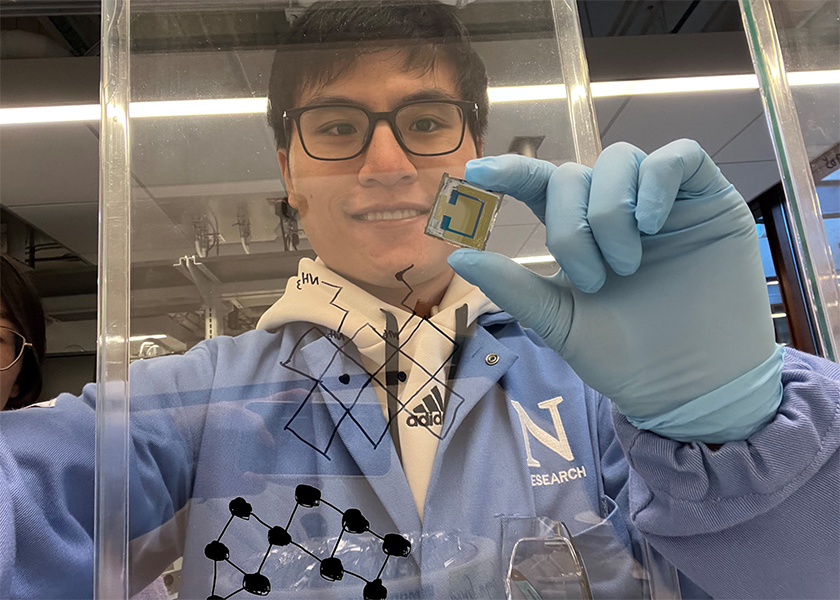The Problem
Perovskite solar cells are potentially a source of renewable power but lack stability.
Perovskite solar cells are potentially a source of renewable power but lack stability.
A material that prevents cations from moving within a material and shortening its lifespan.
Perovskites could be an efficient and green-friendly power source.
Postdoctoral fellow Cheng Liu, Professor Ted Sargent, Professor Mercouri Kanatzidis, Professor Tobin Marks, Adjunct Professor Antonio Facchetti, Research Assistant Professor Bin Chen
Perovskite solar cells (PSCs) show great potential as a source of renewable power, but their stability is still a work in progress. Researchers are working to solve this issue by developing new materials and structures to address the problem and eliminate the bottlenecks around commercializing PSCs.
To achieve that goal, a team of researchers from Northwestern Engineering and Northwestern Chemistry used stable materials structurally similar to perovskites, called perovskitoids. These materials help alleviate the issue of positively charged ions (cations) moving within state-of-the-art perovskite devices that convert light into electrical energy using semiconductor materials. This approach enhances the stability of perovskite solar cells under high-temperature conditions and achieves high efficiency in large-area devices.
“This advance highlights the tremendous potential of perovskitoid materials in surface passivation, paving the way for the large-scale application of perovskite optoelectronic devices,” said Cheng Liu, a postdoctoral fellow jointly in the labs of Professor Ted Sargent and Professor Mercouri Kanatzidis, who served as co-first author on the paper.
The work was presented in the paper “Two-dimensional Perovskitoids Enhance Stability in Perovskite Solar Cells,” published July 8 in the journal Nature.

Researchers included Sargent, Lynn Hopton Davis and Greg Davis Professor of Chemistry and Professor of Electrical and Computer Engineering at Northwestern Engineering, and co-executive director of the Paula M. Trienens Institute for Sustainability and Energy; Kanatzidis, Charles E. and Emma H. Morrison Professor of Chemistry and (by courtesy) Professor of Materials Science and Engineering; Tobin Marks, Vladimir N. Ipatieff Professor of Catalytic Chemistry and Chemical and Biological Engineering and (by courtesy) Materials Science and Engineering; and Bin Chen, research assistant professor at the McCormick School of Engineering.

In several previous studies, Sargent’s lab developed PSCs demonstrating consistent growth in power conversion efficiency, and two-dimensional/three-dimensional perovskite-layered structures have played a key role. However, the migration of positively charged ions switching between the 2D and 3D layers results in material degradation and the decline of a device’s performance.
The research team was keenly aware of this dilemma. The group’s solution was designing a series of materials like perovskites that carry strong organic-inorganic networks to impede ion migration. To do this, the investigators created a 2D perovskitoid structure on the 3D perovskite surface for the first time.
As a result, the work demonstrated suppressed cation migration within the perovskite, improved charge transport by increasing the dimensionality and regulating the orientation of the perovskitoids, and enabled uniform large-area perovskite films. Crucially, the new method achieved the highest efficiency and stability in 1 cm² perovskite devices that convert light into energy.
An innovative technique developed by a team with Professor Ted Sargent leads to perovskite-based solar cells with record-breaking efficiency.
Northwestern researchers created a liquid crystal embedding coating that improved homogeneity for large perovskite films that could one day be used in solar cells.
Professor Ted Sargent improved cell efficiency using a combination of molecules to address different issues.
“Our approach with perovskitoid materials represents a significant leap forward in the stability and efficiency of perovskite solar cells,” Kanatzidis said.
“By integrating these robust materials, we can address the persistent issue of ion migration and move closer to realizing the full potential of perovskite-based technologies."
“The indication from this research is that when addressing a fundamental problem,” Liu said, “it is most effective to uncover the essence of the issue and to then explore solutions from understanding the root cause.”